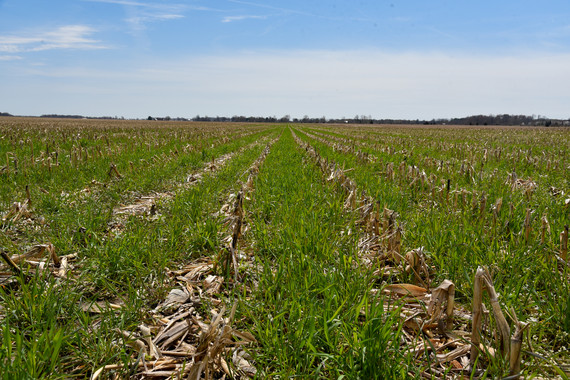
NEWS RELEASE
FOR IMMEDIATE RELEASE
Soil conservation on an upward trend in Indiana
?
INDIANA (July 7, 2022) ?According to a recent conservation survey, Indiana farmers planted an estimated 1.5 million acres of overwinter living covers in the late fall of 2021, matching the record 1.5 million acres planted in 2020, according to the Indiana State Department of Agriculture.
Overwintering living covers (i.e. - cover crops and small grains, like wheat) are known for their environmental benefits. Cover crops and small grains help increase organic matter in the soil and improve overall soil health by adding living roots to the soil additional months out of the year. Cover crops also improve water infiltration into the soil, while other covers, like legumes serve as natural fertilizers.?The 1.5 million acres of living covers planted sequestered an amount of soil organic carbon that is the equivalent of 819,941 tons of CO2.??
Although the conservation transect does not differentiate between cover crops and small grains, Indiana farmers typically plant fewer than 300,000 acres of small grains annually, so cover crops vastly dominate the 1.5 million estimated acres. Except for corn and soybeans, cover crops are planted on more acres than any other commodity crop in Indiana. Cover crops are typically planted in the fall after harvest and are utilized to protect the soil and keep roots in the ground throughout the winter, which improves soil health and helps filter water runoff.
The conservation transect is a visual survey of cropland in the state. It was conducted between March and April 2022 by members of the Indiana Conservation Partnership, including the USDA Natural Resources Conservation Service, the Indiana State Department of Agriculture, Indiana?s Soil and Water Conservation Districts and Purdue Extension, as well as Earth Team volunteers, to show a more complete story of the state?s conservation efforts.
?By increasing our cover crop practices each year, we are ensuring that we provide healthier soil for the next generation,? said Lt. Governor Suzanne Crouch, the Indiana Secretary of Agriculture and Rural Development. ?I am proud of the collaborative efforts being done by our farmers and leaders in Indiana agriculture.?
As a result of the cover crops and other overwintering covers planted last year, it is estimated that 2.1 million tons of sediment was prevented from entering Indiana?s waterways, which is?enough sediment to fill more than 597 Olympic-size swimming pools. Overwintering covers also prevented 5.1 million pounds of nitrogen and over 2.5 million pounds of phosphorus from entering Indiana's waterways.
The conservation survey also showed that about 70 percent of farmed acres were not tilled and 18 percent of farmed acres had employed reduced tillage after the 2021 harvest. This early spring survey is not intended to quantify pre-planting tillage.
?Indiana farmers continue to help lead the way through their dedication to conservation farming,? said Jerry Raynor, state conservationist for USDA?s Natural Resources Conservation Service in Indiana. ?The work being done by farmers throughout the state to promote soil health through no-till farming and the planting of cover crops will have positive impacts for generations to come. We are committed to continuing to help farmers help the land through financial assistance and free conservation technical assistance as they implement these practices and more to help conserve this vital resource.?
Indiana State Department of Agriculture Director Bruce Kettler is excited to see what the future holds for soil conservation in Indiana.
?As recent surveys have proved, soil conservation remains an integral part of how Hoosier farmers care for their land and the work they do," said Kettler. ?With this increasing trend of cover crop acres and soil health, future generations are in trustworthy hands.?
Kurt Theurer is one of the many farmers throughout Indiana seeing the benefits of no-till farming paired with cover crops. Theurer farms 1,650 acres in Jay County, Indiana, evenly split between corn and soybeans. He has no-till farmed and planted cover crops on approximately 400 of his acres for more than a decade and transitioned the remaining acres after he started farming them five years ago. Theurer started cover cropping by testing a small plot with oats. After seeing an immediate impact, he planted his entire farm in cover the next season.
He is also the Jay County Soil and Water Conservation District Board Chairman and has implemented a nutrient and pest management plan on his land with assistance from the USDA Natural Resources Conservation Service.
?I did a small trial at my home farm and the weeds that I had, the resistant weeds, just went from crazy to barely any after I ran a cover crop,? Theurer said. ?The next spring, that soil was just a whole totally different soil type. You could tell in the field the next spring right where we quit our oats."
?We're starting to get a lot of earthworms again,? he continued. ?We're starting to get a lot of root penetration down through our hardpans with all our cover crops. And my organic material that I'm building, I was only at like 1.5 percent organic material when I started and I'm like 2.5-3 percent now. So, I feel that I'm working in the right direction.?
Click here or visit isda.in.gov to see the results from the survey. To visit the Indiana Conservation Data Hub click here.?
###
Note to the press: Pictured below is an Indiana field planted with cover crops.
  ABOUT ISDA
The?Indiana State Department of Agriculture?(ISDA) reports to?Lt. Governor Suzanne Crouch,? Indiana?s Secretary of Agriculture and Rural Development. Major responsibilities include advocacy for Indiana agriculture at the local, state and federal level, managing soil conservation programs, promoting economic development and agricultural innovation, serving as a regulatory ombudsman for agricultural businesses, and licensing grain firms throughout the state.
|
